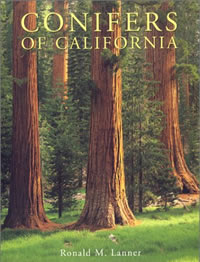 Conifers of California is a delightful introduction to many of our native conifers, as well as the incredible diversity of these cone bearing trees to be found further down the coast. Author Ronald M. Lanner writes what could be best described as a biography of each tree, telling the natural history and the interaction of each with humans and animals. While there are helpful descriptions, (including “At a distance”, “Standing beneath it”, and “In the hand”), this is not primarily a field guide.
Conifers of California is a delightful introduction to many of our native conifers, as well as the incredible diversity of these cone bearing trees to be found further down the coast. Author Ronald M. Lanner writes what could be best described as a biography of each tree, telling the natural history and the interaction of each with humans and animals. While there are helpful descriptions, (including “At a distance”, “Standing beneath it”, and “In the hand”), this is not primarily a field guide.
The photographs are excellent, but a bigger visual draw are the botanical paintings by Eugene Otto Walter Murman (1874-1962), which besides being beautiful, clearly show the distinctiveness of the cones, cone scales, seeds, needles in a single bundle, and a growing tip. Adding to the history are quotes by some of the great describers of trees, including Charles Sprague Sargent, John Muir, and, one of my favorites, Donald Culross Peattie.
I’m adding Lanner to this list. His descriptions of the relationship between the Clark’s nutcracker and whitebark pine (Pinus albicaulis), or the unusual combinations of factors that lead to the long, long lives of the bristlecone pine (Pinus longaeva), are detailed and lengthy but totally engaging.
Of incense-cedar (Calocedrus decurrens) he explains how forestry practices have led to a population explosion of this tree little valued by the timber industry. This is “…good for those Americans who eschew the use of greasy-inked ballpoint pens, because incense-cedar is the unrivaled champion of available domestic pencilwoods. It may not be so good for those…who must past through thickets…for those thin dead, lower limbs seem always positioned to welt a cheek or poke an unsuspecting eye.”
Many of the rarer California conifers can be found in the Arboretum and this book is a good introduction. Look for the Coulter pine (Pinus coulteri) but don’t stand under its eight pound cones
“with talonlike appendages”, while from the Siskiyou Mountains comes the weeping Brewer spruce (Picea breweriana) with “long, dark-foliaged, pendulous branches.”
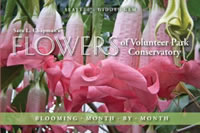 Flowers of Volunteer Park Conservatory is one of the best examples I’ve seen of a book capturing the spirit of a public garden. Photographer Sara L. Chapman has created monthly visual essays, using both close-ups and panoramas to bring you into the page and remind you of a real life visit. But this is more than just a picture book. The subjects of the photos are carefully captioned, making this a useful identification handbook to conservatory plants.
Flowers of Volunteer Park Conservatory is one of the best examples I’ve seen of a book capturing the spirit of a public garden. Photographer Sara L. Chapman has created monthly visual essays, using both close-ups and panoramas to bring you into the page and remind you of a real life visit. But this is more than just a picture book. The subjects of the photos are carefully captioned, making this a useful identification handbook to conservatory plants.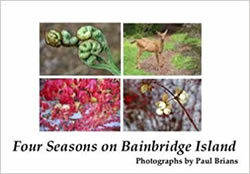 Four Seasons on Bainbridge Island is a photo essay by Paul Brians celebrating the flora of the island, some from his own garden, and accented with a few shots of people, animals, and landscapes. Highly recommended for residents of Bainbridge, this book also captures the essence of semi-rural, island living anywhere around Puget Sound.
Four Seasons on Bainbridge Island is a photo essay by Paul Brians celebrating the flora of the island, some from his own garden, and accented with a few shots of people, animals, and landscapes. Highly recommended for residents of Bainbridge, this book also captures the essence of semi-rural, island living anywhere around Puget Sound. While you’re browsing the tables at your favorite plant sale or nursery, you may notice that many of the plant treasures tempting you have “henryi” or some similar variation in their name. In most cases, these honor Augustine Henry, the Irish customs official who worked for the Chinese government in western China during the 1880s and 1890s.
While you’re browsing the tables at your favorite plant sale or nursery, you may notice that many of the plant treasures tempting you have “henryi” or some similar variation in their name. In most cases, these honor Augustine Henry, the Irish customs official who worked for the Chinese government in western China during the 1880s and 1890s.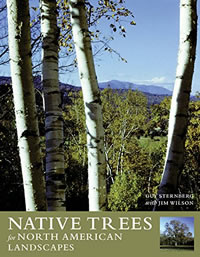
 Bamboo for Gardens is written by Washington State resident, Ted Meredith. While most of the photos are close-ups of their subject, it’s fun to see rhododendrons or a Douglas fir lurking in the background of wider shots.
Bamboo for Gardens is written by Washington State resident, Ted Meredith. While most of the photos are close-ups of their subject, it’s fun to see rhododendrons or a Douglas fir lurking in the background of wider shots. First Lady Michelle Obama’s new book,
First Lady Michelle Obama’s new book,  Conifers of California is a delightful introduction to many of our native conifers, as well as the incredible diversity of these cone bearing trees to be found further down the coast. Author Ronald M. Lanner writes what could be best described as a biography of each tree, telling the natural history and the interaction of each with humans and animals. While there are helpful descriptions, (including “At a distance”, “Standing beneath it”, and “In the hand”), this is not primarily a field guide.
Conifers of California is a delightful introduction to many of our native conifers, as well as the incredible diversity of these cone bearing trees to be found further down the coast. Author Ronald M. Lanner writes what could be best described as a biography of each tree, telling the natural history and the interaction of each with humans and animals. While there are helpful descriptions, (including “At a distance”, “Standing beneath it”, and “In the hand”), this is not primarily a field guide. Andrea Wulf, in The Brother Gardeners, starts at the beginning of the 18th century. Up to that time gardening was “traditionally the preserve of the aristocracy…now, amateur gardeners began to take an obsessive interest in their smaller plots.” Her focus is on the transformation in England, but much of this was fueled by the interchange with American gardeners and particularly the importing of American plants to English gardens.
Andrea Wulf, in The Brother Gardeners, starts at the beginning of the 18th century. Up to that time gardening was “traditionally the preserve of the aristocracy…now, amateur gardeners began to take an obsessive interest in their smaller plots.” Her focus is on the transformation in England, but much of this was fueled by the interchange with American gardeners and particularly the importing of American plants to English gardens.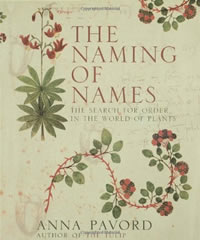 Anna Pavord’s The Naming of Names sets the groundwork for the system of nomenclature we use so freely today. More than just names, this book chronicles the development of human understanding of plants, how they live and propagate, but most importantly how we’ve come to identify and categorized them.
Anna Pavord’s The Naming of Names sets the groundwork for the system of nomenclature we use so freely today. More than just names, this book chronicles the development of human understanding of plants, how they live and propagate, but most importantly how we’ve come to identify and categorized them.